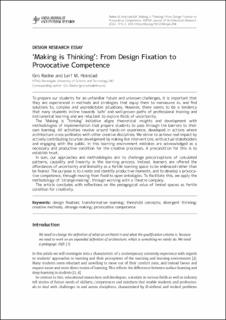| dc.contributor.author | Rødne, Gro | |
| dc.contributor.author | Hokstad, Leif Martin | |
| dc.date.accessioned | 2023-05-05T10:24:49Z | |
| dc.date.available | 2023-05-05T10:24:49Z | |
| dc.date.created | 2022-08-05T10:51:50Z | |
| dc.date.issued | 2022 | |
| dc.identifier.citation | ARENA Journal of Architectural Research (AJAR). 2022, 7 (1), . | en_US |
| dc.identifier.uri | https://hdl.handle.net/11250/3066416 | |
| dc.description.abstract | To prepare our students for an unfamiliar future and unknown challenges, it is important that they are experienced in methods and strategies that equip them to manoeuvre in, and find solutions to, complex and unpredictable situations. However, there seems to be a tendency that many students incline towards ‘safe’ and well-proven paths of professional training and instrumental learning and are reluctant to explore fields of uncertainty. The ‘Making is Thinking’ initiative aligns theoretical insights and development with methodologies of implementation that prepare students to pass through the barriers to their own learning. All activities revolve around hands-on experience, developed in actions where architecture cross-pollinates with other creative disciplines. We strive to achieve real impact by actively contributing to urban development by making live interventions, with actual stakeholders and engaging with the public. In this learning environment mistakes are acknowledged as a necessary and productive condition for the creative processes. A precondition for this is to establish trust. In sum, our approaches and methodologies aim to challenge preconceptions of calculated patterns, causality and linearity in the learning process. Instead, learners are offered the affordances of uncertainty and liminality as a fertile learning space to be embraced rather than be feared. The purpose is to create and identify productive moments, and to develop a provocative competence, through moving from fixed to open ontologies. To facilitate this, we apply the methodology of ‘strange-making’, through working with a theatre company. The article concludes with reflections on the pedagogical value of liminal spaces as fertile condition for creativity. | en_US |
| dc.language.iso | eng | en_US |
| dc.publisher | Ubiquity Press | en_US |
| dc.rights | Navngivelse 4.0 Internasjonal | * |
| dc.rights.uri | http://creativecommons.org/licenses/by/4.0/deed.no | * |
| dc.title | ‘Making is Thinking’: From Design Fixation to Provocative Competence | en_US |
| dc.title.alternative | ‘Making is Thinking’: From Design Fixation to Provocative Competence | en_US |
| dc.type | Journal article | en_US |
| dc.type | Peer reviewed | en_US |
| dc.description.version | publishedVersion | en_US |
| dc.source.pagenumber | 17 | en_US |
| dc.source.volume | 7 | en_US |
| dc.source.journal | ARENA Journal of Architectural Research (AJAR) | en_US |
| dc.source.issue | 1 | en_US |
| dc.identifier.doi | 10.5334/ajar.294 | |
| dc.identifier.doi | 10.5334/ajar.294 | |
| dc.identifier.cristin | 2041348 | |
| cristin.ispublished | true | |
| cristin.fulltext | original | |
| cristin.qualitycode | 1 | |

